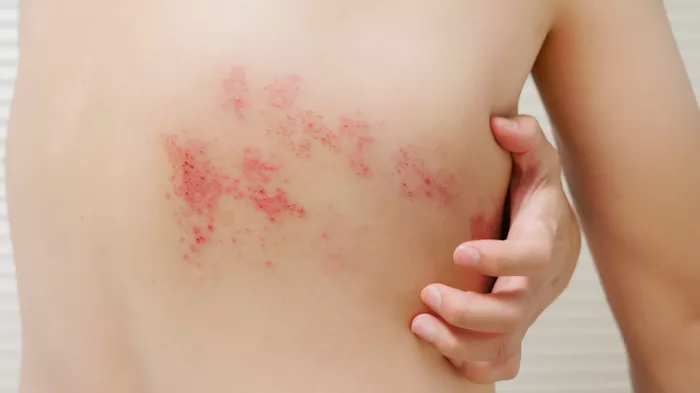Shingles, also known as herpes zoster, is a viral infection caused by the varicella-zoster virus, the same virus that causes chickenpox. After an individual has recovered from chickenpox, the virus remains dormant in the body’s nerve tissues. Years later, the virus can reactivate as shingles, often manifesting as a painful rash. Shingles can affect various parts of the body, but when it occurs on the back, it can be particularly debilitating due to the extensive nerve involvement in this area.
Shingles is most common in older adults and individuals with weakened immune systems. The initial symptoms of shingles often include pain, burning, numbness, or tingling. This is followed by the appearance of a red rash that eventually forms fluid-filled blisters. These blisters typically break open and then crust over. The pain associated with shingles can be severe and is often the most challenging symptom to manage.
Medical Treatments for Shingles on the Back
Antiviral Medications
One of the primary treatments for shingles is antiviral medications. These drugs help reduce the severity and duration of the infection if taken within 72 hours of the appearance of the rash. Common antiviral medications include:
- Acyclovir (Zovirax)
- Valacyclovir (Valtrex)
- Famciclovir (Famvir)
These medications work by inhibiting the replication of the varicella-zoster virus, thus limiting the spread and intensity of the outbreak. Early intervention with antivirals is crucial for minimizing complications, including postherpetic neuralgia, a condition where severe pain persists long after the rash has healed.
Pain Management
Pain management is a critical component of shingles treatment, especially for outbreaks on the back where nerve involvement can be extensive. Several approaches can be employed to manage pain:
Over-the-Counter Pain Relievers
Non-prescription pain relievers, such as acetaminophen (Tylenol) and nonsteroidal anti-inflammatory drugs (NSAIDs) like ibuprofen (Advil, Motrin), can be effective in managing mild to moderate pain associated with shingles.
Prescription Pain Medications
For more severe pain, doctors may prescribe stronger pain medications, including:
- Narcotics (Opioids): Medications like oxycodone or hydrocodone may be used for short-term pain relief.
- Anticonvulsants: Drugs such as gabapentin (Neurontin) and pregabalin (Lyrica) can help reduce nerve pain.
- Antidepressants: Tricyclic antidepressants like amitriptyline can be effective in treating chronic pain and improving sleep.
Topical Treatments
Topical treatments can provide localized relief from shingles pain and discomfort. Options include:
- Lidocaine Patches: These patches can be applied directly to the affected area to numb the pain.
- Capsaicin Cream: This cream, derived from chili peppers, can help reduce pain by depleting substance P, a chemical involved in transmitting pain signals.
Corticosteroids
Corticosteroids, such as prednisone, are sometimes prescribed to reduce inflammation and swelling. However, their use is controversial, and they are generally recommended only in specific cases where significant inflammation is present and other treatments have failed.
Alternative and Complementary Treatments
Natural Remedies
Natural and complementary treatments can be used alongside conventional medical treatments to help manage shingles symptoms. Some popular natural remedies include:
Cool Compresses
Applying cool, wet compresses to the shingles rash can help reduce pain and itching. This simple method can provide temporary relief and is particularly useful in the initial stages of the outbreak.
Colloidal Oatmeal Baths
Soaking in a colloidal oatmeal bath can soothe irritated skin and relieve itching. Colloidal oatmeal has anti-inflammatory properties that can help reduce discomfort and promote healing.
Calamine Lotion
Calamine lotion can be applied to the rash to relieve itching and dry out blisters. It is a tried-and-true remedy for various skin conditions and can be particularly effective for shingles.
SEE ALSO: Does Anthem Blue Cross Cover the Shingles Vaccine?
Herbal Supplements
Certain herbal supplements have shown promise in managing shingles symptoms:
- Lemon Balm: Known for its antiviral properties, lemon balm can be applied as a cream or taken as a tea.
- Echinacea: This herb may boost the immune system and help the body fight off the virus.
- St. John’s Wort: Often used for its antidepressant effects, St. John’s Wort also has antiviral properties and can be used topically or taken as a supplement.
Acupuncture
Acupuncture is an ancient Chinese practice that involves inserting thin needles into specific points on the body to balance energy flow. Some studies suggest that acupuncture can help relieve pain and improve overall well-being in individuals with shingles.
Stress Reduction Techniques
Stress is a known trigger for shingles outbreaks, so stress management is an essential aspect of treatment. Techniques such as yoga, meditation, and deep-breathing exercises can help reduce stress and promote relaxation.
Preventive Measures
Shingles Vaccine
The most effective way to prevent shingles and its complications is through vaccination. The Centers for Disease Control and Prevention (CDC) recommends the shingles vaccine for adults aged 50 and older. There are two vaccines available:
- Shingrix: This is the preferred vaccine and is more than 90% effective at preventing shingles and postherpetic neuralgia. It is administered in two doses, two to six months apart.
- Zostavax: This is an older vaccine that is less effective than Shingrix. It is administered as a single dose.
Vaccination can significantly reduce the risk of developing shingles and the severity of the disease if it does occur.
Healthy Lifestyle
Maintaining a healthy lifestyle can strengthen the immune system and reduce the likelihood of a shingles outbreak. Key components of a healthy lifestyle include:
- Balanced Diet: Eating a diet rich in fruits, vegetables, whole grains, and lean proteins can boost immune function.
- Regular Exercise: Physical activity can enhance immune response and overall health.
- Adequate Sleep: Getting enough sleep is crucial for immune health and overall well-being.
- Stress Management: Managing stress through relaxation techniques, hobbies, and social activities can help prevent shingles outbreaks.
Postherpetic Neuralgia Management
Postherpetic neuralgia (PHN) is a common complication of shingles, characterized by persistent pain long after the rash has healed. Treatment for PHN includes many of the same medications used for acute shingles pain, such as anticonvulsants, antidepressants, and topical treatments. Additionally, other strategies may be employed:
Nerve Blocks
Nerve blocks involve injecting an anesthetic directly into the affected nerves to relieve pain. This can provide significant relief for individuals with severe PHN.
Transcutaneous Electrical Nerve Stimulation (TENS)
TENS is a non-invasive therapy that uses low-voltage electrical currents to relieve pain. Electrodes are placed on the skin near the painful area, and the electrical impulses help to block pain signals from reaching the brain.
Physical Therapy
Physical therapy can help improve mobility and reduce pain through exercises and stretches tailored to the individual’s needs. Physical therapists may also use techniques such as heat therapy, massage, and ultrasound to alleviate pain.
Conclusion
Shingles on the back can be a particularly painful and debilitating condition, but with prompt and effective treatment, the severity and duration of the outbreak can be minimized. A combination of antiviral medications, pain management strategies, topical treatments, and alternative therapies can provide comprehensive relief. Preventive measures, including vaccination and maintaining a healthy lifestyle, are crucial in reducing the risk of shingles and its complications. By employing a multifaceted approach to treatment and prevention, individuals can manage shingles effectively and improve their quality of life.
Related Topics:


























